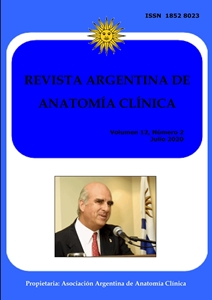Morphometric study of the iliac bifurcation and its application to iliac branch devices.
DOI:
https://doi.org/10.31051/1852.8023.v12.n2.28501Keywords:
Aorta; Common iliac artery; Internal Iliac artery; Aneurysm; Anatomy.Abstract
Introduction: Endovascular repair of aorto-iliac aneurysms by means of iliac branch devices allows both proper aneurysmal sealing and patency of the pelvic circulation. However, not all anatomies are suitable for this type of technology. This motivated the present study whose objective was to evaluate the compatibility of the anatomy of the iliac vessels to the specifications of the manufacturers of these devices, in a cadaveric population. Materials and methods: 53 arterial iliac bifurcations were dissected from adult formalin-fixed cadavers. It was registered: gender, side (right or left), length of the common iliac artery (L1), hypogastric arterial length (L2), and caliber of the common iliac artery (C1), iliac bifurcation (C2), hypogastric artery (C3) and external iliac artery (C4). These results were compared with the specifications of 3 manufacturers of iliac branch devices commonly used in our region. Results: The average values obtained were: L1: 54,52 mm; L2: 40,59 mm; C1: 11,73 mm; C2: 15,34 mm; C3: 7,28 mm; C4: 8,36 mm. From the total cases studied, only 5 cases (9.43%) met the requirements of the first manufacturer, the remaining 48 cases (90,57%) did not. Eight (15,09%) cases met the criteria of the second manufacturer while 45 specimens (84,91%) did not. Eighteen cases (33,96%) met the requirements of the third manufacturer while the remaining 35 cases (66,04%) did not. Conclusions: Since not every case was suitable for iliac branch device, the surgeon must be aware of this and other type of devices for proper aortic-iliac aneurysmal distal sealing. It is crucial to determine the morphometry of each case in order to evaluate its suitability for iliac branch device use.
Downloads
References
Armon MP, Wenham PW, Whitaker SC, Gregson RH, Hopkinson BR. 1998. Common iliac artery aneurysms in patients with abdominal aortic aneurysms. Eur J Vasc Endovasc Surg 15: 255-57.
Chaikof EL, Dalman RL, Eskandari MK, Jackson BM, Lee WA, Mansour MA, Starnes BW. 2018. The Society for Vascular Surgery practice guidelines on the care of patients with an abdominal aortic aneurysm. J Vasc Surg 67: 2-77.
Cook Medical. 2017. Physician´s pocket reference guide. URL: www.cookmedical.com (consultado en mayo 2020).
Criado FJ, Wilson EP, Velazquez OC, Carpenter JP, Barker C, Wellons E, Abul-Khoudoud O, Fairman RM. 2000. Safety of coil embolization of the internal iliac artery in endovascular grafting of abdominal aortic aneurysms. J Vasc Surg 32: 684–88.
D’oria M, Mastrorilli D, Demartino R, Lepidi S. 2019. Current status of endovascular preservation of the internal iliac artery with iliac branch devices (IBD). Cardiovasc Intervent Radiol 42: 935–48.
Gore WL & Associates. 2014. Gore excluder iliac branch endoprosthesis - catalogue. URL: www.goremedical.com (consultado en mayo 2020).
Greenhalgh M. 2018. Vascular and endovascular controversies update - 40 year of looking forward. Inglaterra: BIBA Publishing, pág: 1-504.
Itoga NK, Fujimura N, Hayashi K, Obara H, Shimizu H, Lee JT. 2017. Outcomes of endovascular repair of aortoiliac aneurysms and analyses of anatomic suitability for internal iliac artery preserving devices in japanese patients. Circ J 81: 682–88.
Jongsma H, Bekken JA, Bekkers WJJ, Zeebregts CJ, Van Herwaarden J, Hoksbergen A, Cuypers P,de Vries JPPM, Verhagen HJ, Fioole B. 2017. Endovascular treatment of common iliac artery aneurysms with an iliac branch device: Multicenter experience of 140 patients. J Endovasc Ther 24: 239–45.
Jotec GmbH. 2015. E-iliac - product catalogue. URL: www.jotec.com (consultado en mayo 2020).
Karthikesalingam A, Hinchliffe RJ, Holt PJE, Boyle JR, Loftus IM, Thompson MM. 2010. Endovascular aneurysm repair with preservation of the internal iliac artery using the iliac branch graft device. Eur J Vasc Endovasc Surg 39, 285–94.
Kayssi A, Neville RF. 2018. Hypogastric preservation during treatment of aortoiliac aneurysms. Tech Vasc Interv Radiol 21: 175–80.
Krejza J, Arkuszewski M, Kasner SE, Weigele J, Ustymowicz A, Hurst RW, Cucchiara BL, Messe SR. 2006. Carotid artery diameter in men and women and the relation to body and neck size. Stroke 37: 1103–05.
Loth AG, Rouhani G, Gafoor SA, Sievert H, Stelter WJ. 2015. Treatment of iliac artery bifurcation aneurysms with the second-generation straight iliac bifurcated device. J Vasc Surg 62: 1168–75.
Oderich GS, Greenberg RK. 2011. Endovascular iliac branch devices for iliac aneurysms. Perspect Vasc Surg Endovasc Ther 23: 166–72.
Pearce BJ, Varu VN, Glocker R, Novak Z, Jordan WD, Lee JT. 2015. Anatomic suitability of aortoiliac aneurysms for next generation branched systems. Ann Vasc Surg 29: 69–75.
Rayt HS, Bown MJ, Lambert KV, Fishwick NG, McCarthy MJ, London NJM, Sayers RD. 2008. Buttock claudication and erectile dysfunction after internal iliac artery embolization in patients prior to endovascular aortic aneurysm repair. Cardiovasc Intervent Radiol 31: 728–34.
Schneider DB, Matsumura JS, Lee JT, Peterson BG, Chaer RA, Oderich GS. 2017. Prospective, multicenter study of endovascular repair of aortoiliac and iliac aneurysms using the Gore Iliac Branch Endoprosthesis. J Vasc Surg 66: 775–85.
Downloads
Published
How to Cite
Issue
Section
License
Copyright (c) 2020 Leticia Vázquez, María Florencia Ignatov, Juan Enrique Kenny , Alejandro Marcel Russo

This work is licensed under a Creative Commons Attribution-NonCommercial 4.0 International License.
Authors retain copyright and grant the journal right of first publication with the work simultaneously licensed under a Creative Commons Attribution License that allows others to share the work with an acknowledgement of the work's authorship and initial publication in this journal. Use restricted to non commercial purposes.
Once the manuscript has been accepted for publications, authors will sign a Copyright Transfer Agreement to let the “Asociación Argentina de Anatomía Clínica” (Argentine Association of Clinical Anatomy) to edit, publish and disseminate the contribution.



